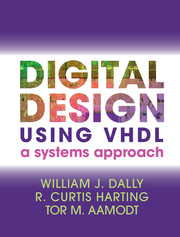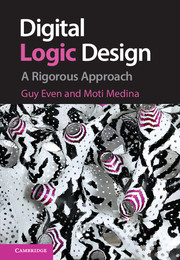Digital Design Using VHDL
This introductory textbook provides students with a system-level perspective and the tools they need to understand, analyze and design digital systems. Going beyond the design of simple combinational and sequential modules, it shows how such modules are used to build complete systems, reflecting real-world digital design. All the essential topics are covered, including design and analysis of combinational and sequential modules, as well as system timing and synchronization. It also teaches how to write VHDL-2008 HDL in a productive and maintainable style that enables CAD tools to do much of the tedious work. A complete introduction to digital design is given through clear explanations, extensive examples and online VHDL files. The teaching package is completed with lecture slides, labs and a solutions manual for instructors. Assuming no previous digital knowledge, this textbook is ideal for undergraduate digital design courses that will prepare students for modern digital practice.
- Takes a system-level approach that better prepares students for modern digital design in the real world
- Includes all the essential topics, from composition of combinational modules to system timing and synchronization
- Teaches students how to write VHDL-2008 HDL in a productive and maintainable style that enables modern CAD tools to do much of the tedious work
- VHDL files, solutions, slides and labs are provided online
Product details
December 2015Hardback
9781107098862
721 pages
239 × 193 × 36 mm
1.61kg
489 b/w illus. 68 tables
Available
Table of Contents
- Part I. Introduction:
- 1. The digital abstraction
- 2. The practice of digital system design
- Part II. Combinational Logic:
- 3. Boolean algebra
- 4. CMOS logic circuits
- 5. Delay and power of CMOS circuits
- 6. Combinational logic design
- 7. VHDL descriptions of combinational logic
- 8. Combinational building blocks
- 9. Combinational examples
- Part III. Arithmetic Circuits:
- 10. Arithmetic circuits
- 11. Fixed- and floating-point numbers
- 12. Fast arithmetic circuits
- 13. Arithmetic examples
- Part IV. Synchronous Sequential Logic:
- 14. Sequential logic
- 15. Timing constraints
- 16. Datapath sequential logic
- 17. Factoring finite-state machines
- 18. Microcode
- 19. Sequential examples
- Part V. Practical Design:
- 20. Verification and test
- Part VI. System Design:
- 21. System-level design
- 22. Interface and system-level timing
- 23. Pipelines
- 24. Interconnect
- 25. Memory systems
- Part VII. Asynchronous Logic:
- 26. Asynchronous sequential circuits
- 27. Flip-flops
- 28. Metastability and synchronization failure
- 29. Synchronizer design
- Appendix A. VHDL coding style
- Appendix B. VHDL syntax guide
- References
- Index.







